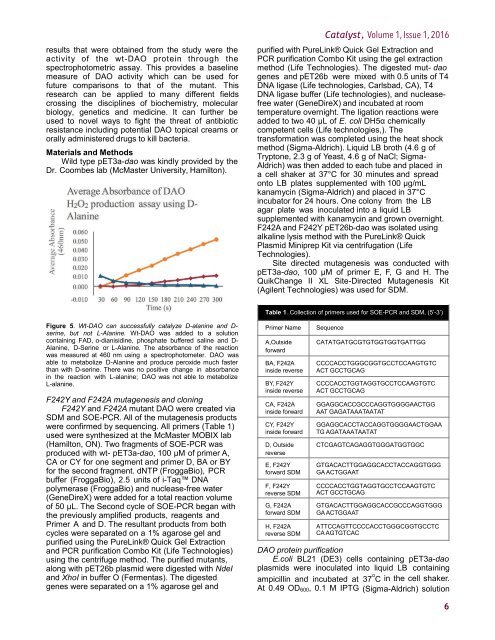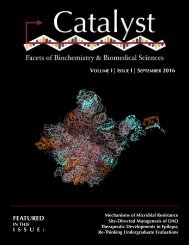Catalyst 2016
Create successful ePaper yourself
Turn your PDF publications into a flip-book with our unique Google optimized e-Paper software.
esults that were obtained from the study were the<br />
activity of the wt-DAO protein through the<br />
spectrophotometric assay. This provides a baseline<br />
measure of DAO activity which can be used for<br />
future comparisons to that of the mutant. This<br />
research can be applied to many different fields<br />
crossing the disciplines of biochemistry, molecular<br />
biology, genetics and medicine. It can further be<br />
used to novel ways to fight the threat of antibiotic<br />
resistance including potential DAO topical creams or<br />
orally administered drugs to kill bacteria.<br />
Materials and Methods<br />
Wild type pET3a-dao was kindly provided by the<br />
Dr. Coombes lab (McMaster University, Hamilton).<br />
<strong>Catalyst</strong>, Volume 1, Issue 1, <strong>2016</strong><br />
purified with PureLink® Quick Gel Extraction and<br />
PCR purification Combo Kit using the gel extraction<br />
method (Life Technologies). The digested mut- dao<br />
genes and pET26b were mixed with 0.5 units of T4<br />
DNA ligase (Life technologies, Carlsbad, CA), T4<br />
DNA ligase buffer (Life technologies), and nucleasefree<br />
water (GeneDireX) and incubated at room<br />
temperature overnight. The ligation reactions were<br />
added to two 40 µL of E. coli DH5α chemically<br />
competent cells (Life technologies,). The<br />
transformation was completed using the heat shock<br />
method (Sigma-Aldrich). Liquid LB broth (4.6 g of<br />
Tryptone, 2.3 g of Yeast, 4.6 g of NaCl; Sigma-<br />
Aldrich) was then added to each tube and placed in<br />
a cell shaker at 37°C for 30 minutes and spread<br />
onto LB plates supplemented with 100 µg/mL<br />
kanamycin (Sigma-Aldrich) and placed in 37°C<br />
incubator for 24 hours. One colony from the LB<br />
agar plate was inoculated into a liquid LB<br />
supplemented with kanamycin and grown overnight.<br />
F242A and F242Y pET26b-dao was isolated using<br />
alkaline lysis method with the PureLink® Quick<br />
Plasmid Miniprep Kit via centrifugation (Life<br />
Technologies).<br />
Site directed mutagenesis was conducted with<br />
pET3a-dao, 100 µM of primer E, F, G and H. The<br />
QuikChange II XL Site-Directed Mutagenesis Kit<br />
(Agilent Technologies) was used for SDM.<br />
Table 1. Collection of primers used for SOE-PCR and SDM, (5’-3’)<br />
Figure 5. Wt-DAO can successfully catalyze D-alanine and D-<br />
serine, but not L-Alanine. Wt-DAO was added to a solution<br />
containing FAD, o-dianisidine, phosphate buffered saline and D-<br />
Alanine, D-Serine or L-Alanine. The absorbance of the reaction<br />
was measured at 460 nm using a spectrophotometer. DAO was<br />
able to metabolize D-Alanine and produce peroxide much faster<br />
than with D-serine. There was no positive change in absorbance<br />
in the reaction with L-alanine; DAO was not able to metabolize<br />
L-alanine.<br />
F242Y and F242A mutagenesis and cloning<br />
F242Y and F242A mutant DAO were created via<br />
SDM and SOE-PCR. All of the mutagenesis products<br />
were confirmed by sequencing. All primers (Table 1)<br />
used were synthesized at the McMaster MOBIX lab<br />
(Hamilton, ON). Two fragments of SOE-PCR was<br />
produced with wt- pET3a-dao, 100 µM of primer A,<br />
CA or CY for one segment and primer D, BA or BY<br />
for the second fragment. dNTP (FroggaBio), PCR<br />
buffer (FroggaBio), 2.5 units of i-Taq DNA<br />
polymerase (FroggaBio) and nuclease-free water<br />
(GeneDireX) were added for a total reaction volume<br />
of 50 µL. The Second cycle of SOE-PCR began with<br />
the previously amplified products, reagents and<br />
Primer A and D. The resultant products from both<br />
cycles were separated on a 1% agarose gel and<br />
purified using the PureLink® Quick Gel Extraction<br />
and PCR purification Combo Kit (Life Technologies)<br />
using the centrifuge method. The purified mutants,<br />
along with pET26b plasmid were digested with NdeI<br />
and XhoI in buffer O (Fermentas). The digested<br />
genes were separated on a 1% agarose gel and<br />
Primer Name<br />
A,Outside<br />
forward<br />
BA, F242A<br />
inside reverse<br />
BY, F242Y<br />
inside reverse<br />
CA, F242A<br />
inside forward<br />
CY, F242Y<br />
inside forward<br />
D, Outside<br />
reverse<br />
E, F242Y<br />
forward SDM<br />
F, F242Y<br />
reverse SDM<br />
G, F242A<br />
forward SDM<br />
H, F242A<br />
reverse SDM<br />
Sequence<br />
CATATGATGCGTGTGGTGGTGATTGG<br />
CCCCACCTGGGCGGTGCCTCCAAGTGTC<br />
ACT GCCTGCAG<br />
CCCCACCTGGTAGGTGCCTCCAAGTGTC<br />
ACT GCCTGCAG<br />
GGAGGCACCGCCCAGGTGGGGAACTGG<br />
AAT GAGATAAATAATAT<br />
GGAGGCACCTACCAGGTGGGGAACTGGAA<br />
TG AGATAAATAATAT<br />
CTCGAGTCAGAGGTGGGATGGTGGC<br />
GTGACACTTGGAGGCACCTACCAGGTGGG<br />
GA ACTGGAAT<br />
CCCCACCTGGTAGGTGCCTCCAAGTGTC<br />
ACT GCCTGCAG<br />
GTGACACTTGGAGGCACCGCCCAGGTGGG<br />
GA ACTGGAAT<br />
ATTCCAGTTCCCCACCTGGGCGGTGCCTC<br />
CA AGTGTCAC<br />
DAO protein purification<br />
E.coli BL21 (DE3) cells containing pET3a-dao<br />
plasmids were inoculated into liquid LB containing<br />
ampicillin and incubated at 37 o C in the cell shaker.<br />
At 0.49 OD 600 , 0.1 M IPTG (Sigma-Aldrich) solution<br />
6




